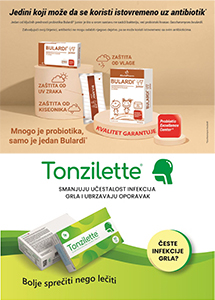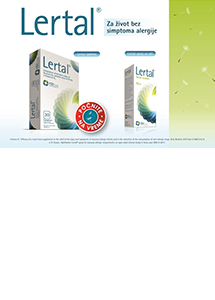IRRITABLE BOWEL SYNDROME IN CHILDREN - HOW TO GET DIAGNOSED
DOI:
https://doi.org/10.46793/PP180319005RKeywords:
Irritable bowel syndrome, children, pathogenesis, diagnosis, Rome criteria, Sindrom iriabilnog crevaAbstract
Irritable bowel syndrome (IBS) is a chronic and relapsing functional gastrointestinal disorder. IBS affects 9%-23% of the population across the world. Epidemiologic studies in populations less than 18 years of age suggest higher prevalence among teenagers and children compared to adult population. The pathophysiology of IBS is not yet completely understood and seems to be multifactorial. Many pathogenetic factors, in various combinations, and not all necessarily present in each patient, can play an important role. Discomfort or abdominal pain relieived by defecation, asociated with a change in stool form, is a typical clinical manifestation of IBS. Some factors, such as emotional stress and some food, may initiate and exacerbate the symptoms. A timely diagnosis of IBS is important so that treatment which will provide adequate symptomatic relief (pain and bloating, diarrhoea, constipation) can be introduced. There is no specific test for diagnosing IBS. The diagnosis is made using criteria based on clinical symptoms such as Rome criteria. Today the Rome Criteria IV is the gold-standard for the diagnoses of IBS in the adult and child populations. Treatment of patients with IBS requires a multidisciplinary approach. Some patients respond well to non-pharmacological treatment, while others require pharmacological treatment.
References
Sinagra E, Romano C, Cottone M. Psychopharmacological treatment and psychological interventions in irritable bowel syndrome. Gastroenterol Res Pract 2012;2012:486067.
Belcaro G, Gizzi G, Pellegrini L, Corsi M, Dugall M, Cacchio M, et al. Supplementation with a lecithin-based delivery form of Boswellia serrata extract (Casperome®) controls symptoms of mild irritable bowel syndrome. Eur Rev Med Pharmacol Sci. 2017;21(9):2249-2254.
Lovell RM, Ford AC. Global prevalence of and risk factors for irritable bowel syndrome: a meta-analysis. Clin Gastroenterol Hepatol. 2012;10(7):712-721.
Soares RL. Irritable bowel syndrome: A clinical review. World J Gastroenterol. 2014;20(34):12144-60.
Noddin L, Callahan M, Lacy BE. Irritable bowel syndrome and functional dyspepsia: different diseases or a single disorder with different manifestations? MedGenMed. 2005;7(3):17.
Scalera A, Loguercio C. Focus on irritable bowel syndrome. Eur Rev Med Pharmacol. Sci 2012;16(9):1155-71.
Saha L. Irritable bowel syndrome: pathogenesis, diagnosis, treatment, and evidence-based medicine.World J Gastroenterol. 2014;20(22):6759-6773.
Canavan C, West J, Card T. The epidemiology of irritable bowel syndrome. Clin Epidemiol. 2014;6:71-80.
Grundmann O, Yoon SL. Irritable bowel syndrome: Epidemiology, diagnosis and treatment: An update for healthcare practitioners. J Gastroenterol Hepatology. 2010 ;25(4):691-699.
National Institute for Health and Care Excellence. Developing NICE guidelines: the manual [internet]. London: National Institute for Health and Care Excellence (NICE); 2015.
Karabulut GS, Beşer OF, Erginöz E, Kutlu T, Cokuğraş FÇ, Erkan T. The Incidence of Irritable Bowel Syndrome in Children Using the Rome III Criteria and the Effect of Trimebutine Treatment. J Neurogastroenterol Motil. 2013;19(1):90-3. doi: 10.5056/jnm.2013.19.1.90.
Rajindrajith S, Devanarayana NM. Subtypes and Symptomatology of Irritable Bowel Syndrome in Children and Adolescents: A School-based Survey Using Rome III Criteria. J Neurogastroenterol Motil. 2012;18(3):298-304.doi: 10.5056/jnm.2012.18.3.298.
McOmber ME, Shulman RJ. Recurrent Abdominal Pain and Irritable Bowel Syndrome in Children. Current opinion in pediatrics.2007;19(5):581-585. doi:10.1097/MOP.0b013e3282bf6ddc.
Zhou H, Li D, Cheng G, Fan J, Lu H. An epidemiologic study of irritable bowel syndrome in adolescents and children in South China: a school-based study. Child Care Health Dev. 2010;36(6):781-6. doi: 10.1111/j.1365-2214.2010.01120.x.
Zhu X, Chen W, Zhu X, Shen Y. A cross-sectional study of risk factors for irritable bowel syndrome in children 8-13 years of age in suzhou, china. Gastroenterol Res Pract. 2014;2014:198461. doi: 10.1155/2014/198461
Lovell RM, Ford AC. Global prevalence of and risk factors for irritable bowel syndrome: a meta-analysis. Clin Gastroenterol Hepatol. 2012;10(7):712-721.
Mohammed I, Cherkas LF, Riley SA, Spector TD, Trudgill NJ. Genetic influences in irritable bowel syndrome: a twin study. Am J Gastroenterol. 2005;100(6):1340-4.
Bellini M, Gambaccini D, Stasi C, Urbano MT, Marchi S, Usai-Satta P. Irritable bowel syndrome: A disease still searching for pathogenesis, diagnosis and therapy. World J Gastroenterol. 2014;20(27):8807-8820.
Chumpitazi BP, Shulman RJ. Underlying molecular and cellular mechanisms in childhood irritable bowel syndrome. Molecular and Cellular Pediatrics. 2016;3:11.
Drossman DA. Functional gastrointestinal disorders: history, pathophysiology, clinical features and Rome IV. Gastroenterology. 2016;150:1262-1279.
Posserud I, Ersryd A, Simrén M. Functional findings in irritable bowel syndrome. World J Gastroenterol. 2006;12(18):2830-8.
Dorn SD, Palsson OS, Thiwan SI, Kanazawa M, Clark WC, van Tilburg MA, et al. Increased colonic pain sensitivity in irritable bowel syndrome is the result of an increased tendency to report pain rather than increased neurosensory sensitivity. Gut. 2007;56(9):1202-9.
Benninga MA, Faure C, HymanPE, et al. Childhood functional gastrointestinal disorders: neonate/toddler. Gastroenterology. 2016;150(6):1443–1455.e2.
Hyland NP, Quigley EM, Brint E. Microbiota-host interactions in irritable bowel syndrome: Epithelial barrier, immune regulation and brain-gut interactions.World Journal of Gastroenterology: WJG. 2014;20(27):8859-8866.
Atkinson W, Sheldon TA, Shaath N, Whorwell PJ. Food elimination based on IgG antibodies in irritable bowel syndrome: a randomised controlled trial. Gut. 2004;53(10):1459-64.
Elli L, Branchi F, Tomba C, Villalta D, Norsa L, Ferretti F, et al. Diagnosis of gluten related disorders: Celiac disease, wheat allergy and non-celiac gluten sensitivity. World Journal of Gastroenterology: WJG .2015;21(23):7110-7119.
Seo AY, Kim N, Oh DH. Abdominal Bloating: Pathophysiology and Treatment.Journal of Neurogastroenterology and Motility. 2013;19(4):433-453.
Sunderland R. Irritable bowel syndrome in adults: symptoms, treatment and management. Nurs Stand. 2017;31(26):52-63.
Koppen IJ, Nurko S, Saps M, Di Lorenzo C, Benninga MA.The pediatric Rome IV criteria: what's new? Expert Rev Gastroenterol Hepatol. 2017;11(3):193-201. doi: 10.1080/17474124.2017.1282820. Schmulson MJ, Drossman DA. What Is New in Rome IV. Neurogastroenterol Motil. 2017;23(2):151-163.
Simren M, Palsson OS, Whitehead WE. Update on Rome IV Criteria for Colorectal Disorders: Implications for Clinical Practice. Curr Gastroenterol Rep. 2017;19(4):15.
Drossman DA, Thompson WG, Talley NJ, Funch-Jensen P, Janssens J, Whitehead WE. Identification of subgroups of functional bowel disorders. Gastroenterology International. 1990;3(4):159-172.






